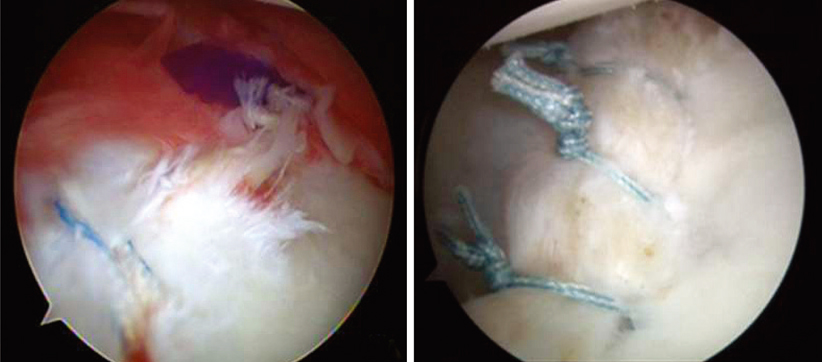Yonsei Med J.
2010 May;51(3):421-426. 10.3349/ymj.2010.51.3.421.
The Spectrum of Lesions and Clinical Results of Arthroscopic Stabilization of Acute Anterior Shoulder Instability
- Affiliations
-
- 1Department of Orthopaedic Surgery, Yonsei University Wonju College of Medicine, Wonju, Korea. dskim1974@hanmail.net
- KMID: 1074995
- DOI: http://doi.org/10.3349/ymj.2010.51.3.421
Abstract
- PURPOSE
The purpose of this study is to investigate and analyze accom-panying lesions including injury types of anteroinferior labrum lesion in young and active patients who suffered traumatic anterior shoulder dislocation for the first time. Meterials and Methods: The study used magnetic resonance angiography (MRA) to 40 patients with acute anterior shoulder dislocation from April 2004 to April 2008, and of those, 36 with abnormal MRA finding were treated with arthroscopy.
RESULTS
There was a total of 25 cases of anteroinferior glenoid labrum lesions. A superior labrum anterior-posterior lesion (SLAP) lesion was observed in 8 cases. For bony lesions, 22 cases of Hill-sachs lesions, 4 cases of lesions in greater tuberosity fracture of humerus, and 4 cases of loose body were found. For lesions involving rotator cuff, partial articular side rupture was found in 2 cases and 2 cases were found to have a complete rupture.
CONCLUSION
Under MRA and arthroscopy performed on patients with acute anterior shoulder dislocation, it was observed to have varying types of anteroinferior labrum lesions such as Perthes, Bankart, ALPSA, and bony Bankart lesion. that MRA is a remar-kably useful tool to classify various lesions in acute anterior dislocation of the shoulder and to make a diagnosis, making it a useful tool to decide a treatment method while consulting patients and their families.
MeSH Terms
Figure
Reference
-
1. Itoi E, Hatakeyama Y, Urayama M, Pradhan RL, Kido T, Sato K. Position of immobilization after dislocation of the shoulder. A cadaveric study. J Bone Joint Surg Am. 1999. 81:385–390.
Article2. Arciero RA, Taylor DC, Snyder RJ, Uhorchak JM. Arthroscopic bioabsorbable tack stabilization of initial anterior shoulder dislocations: a preliminary report. Arthroscopy. 1995. 11:410–417.
Article3. Arciero RA, Wheeler JH, Ryan JB, McBride JT. Arthroscopic Bankart repair versus nonoperative treatment for acute, initial anterior shoulder dislocations. Am J Sports Med. 1994. 22:589–594.
Article4. DeBerardino TM, Arciero RA, Taylor DC. Arthroscopic stabilization of acute initial anterior shoulder dislocation: the West Point experience. J South Orthop Assoc. 1996. 5:263–271.5. O'Neill DB. Arthroscopic Bankart repair of anterior detachments of the glenoid labrum. A prospective study. J Bone Joint Surg Am. 1999. 81:1357–1366.6. Wheeler JH, Ryan JB, Arciero RA, Molinari RN. Arthroscopic versus nonoperative treatment of acute shoulder dislocations in young athletes. Arthroscopy. 1989. 5:213–217.7. Cofield RH, Irving JF. Evaluation and classification of shoulder instability. With special reference to examination under anesthesia. Clin Orthop Relat Res. 1987. (223):32–43.8. Molina V, Pouliart N, Gagey O. Quantitation of ligament laxity in anterior shoulder instability: an experimental cadaver model. Surg Radiol Anat. 2004. 26:349–354.9. Rowe CR, Zarins B. Recurrent transient subluxation of the shoulder. J Bone Joint Surg Am. 1981. 63:863–872.
Article10. Seybold D, Gekle C, Fehmer T, Pennekamp W, Muhr G, Kälicke T. [Immobilization in external rotation after primary shoulder dislocation.]. Chirurg. 2006. 77:821–826.11. Barber FA, Ryu RK, Tauro JC. Should first time anterior shoulder dislocations be surgically stabilized? Arthroscopy. 2003. 19:305–309.
Article12. Walton J, Paxinos A, Tzannes A, Callanan M, Hayes K, Murrell GA. The unstable shoulder in the adolescent athlete. Am J Sports Med. 2002. 30:758–767.
Article13. Bottoni CR, Wilckens JH, DeBerardino TM, D'Alleyrand JC, Rooney RC, Harpstrite JK, et al. A prospective, randomized evaluation of arthroscopic stabilization versus nonoperative treatment in patients with acute, traumatic, first-time shoulder dislocations. Am J Sports Med. 2002. 30:576–580.14. Kirkley A, Werstine R, Ratjek A, Griffin S. Prospective randomized clinical trial comparing the effectiveness of immediate arthroscopic stabilization versus immobilization and rehabilitation in first traumatic anterior dislocations of the shoulder: long-term evaluation. Arthroscopy. 2005. 21:55–63.
Article15. Kim SH, Ha KI, Cho YB, Ryu BD, Oh I. Arthroscopic anterior stabilization of the shoulder: two to six-year follow-up. J Bone Joint Surg Am. 2003. 85-A:1511–1518.
- Full Text Links
- Actions
-
Cited
- CITED
-
- Close
- Share
- Similar articles
-
- Current Concepts in Arthroscopic Treatment of Anterior Shoulder Instability
- Arthroscopic Technique of Bone Defect in Anterior Shoulder Instability
- Various Pathologic Lesions Associated with Anterior Shoulder Instability: Experience over 10-Years of Arthroscopic Treatment
- Arthroscopic Stabilization Using Remplissage Technique in Recurrent Shoulder Instability with Large Hill-Sachs Lesion
- Anterior Shoulder Instability with Concomitant Superior Labrum from Anterior to Posterior (SLAP) Lesion Compared to Anterior Instability without SLAP Lesion




